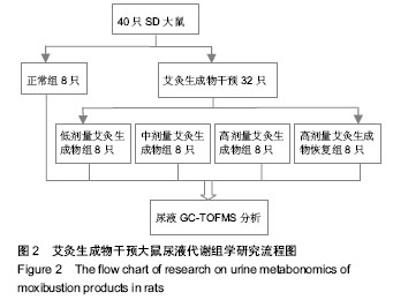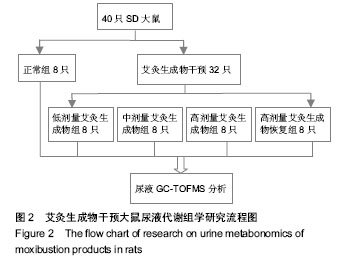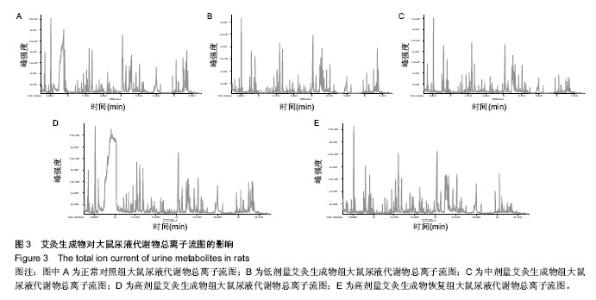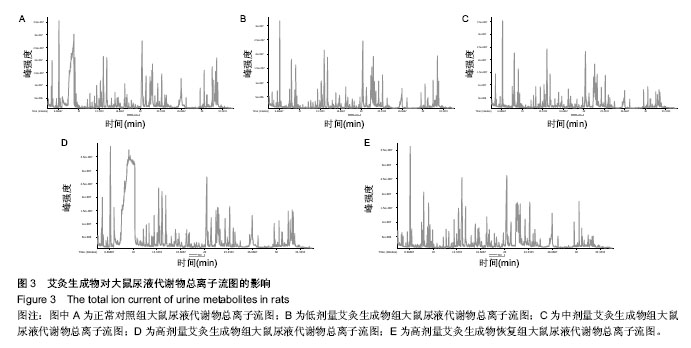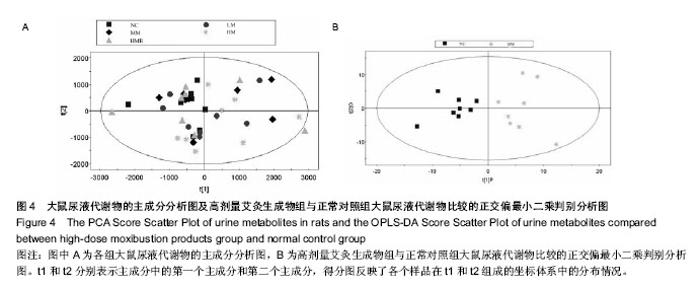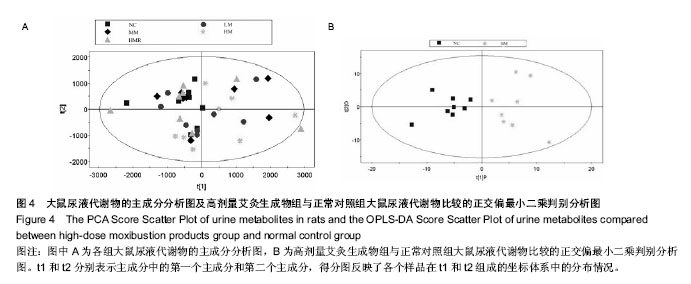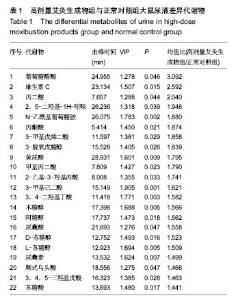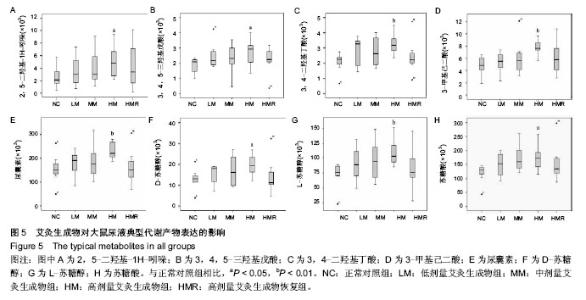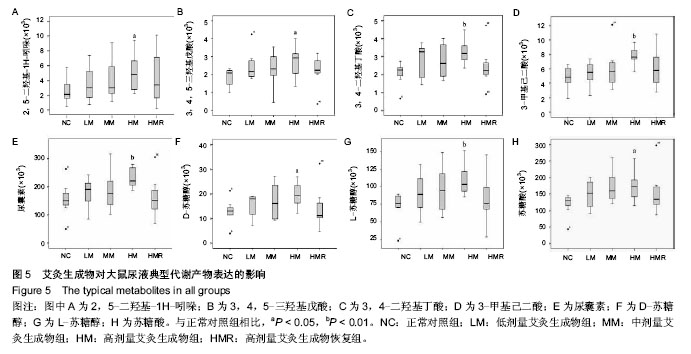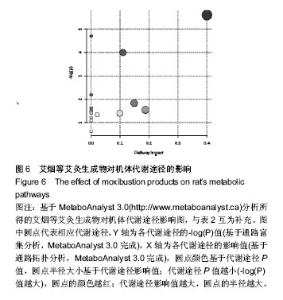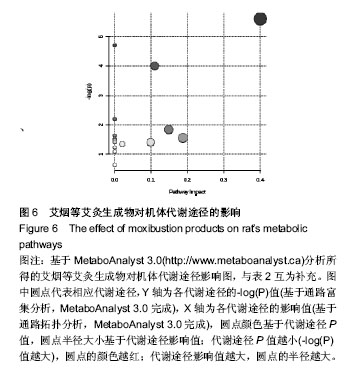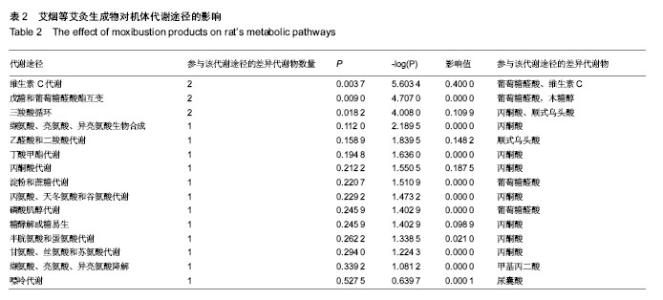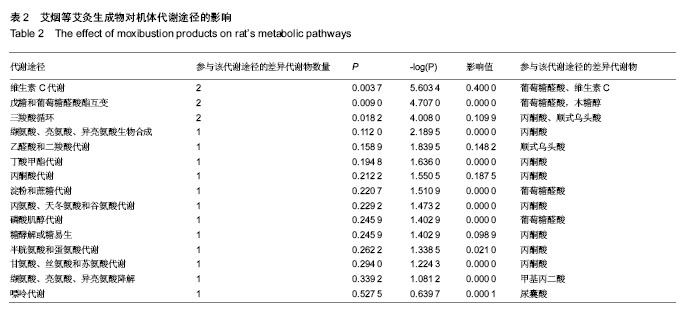| [1] 吴焕淦,马晓芃,周次利,等.灸法研究现状与战略思考[J].世界中医药,2013,8(8):845-851.
[2] 齐丽珍,马晓芃,洪珏.古今灸材及灸法的比较[J].中华中医药学刊, 2013,31(11):2349-2354.
[3] 刘迈兰,曾芳,和中浚,等.艾为最佳施灸材料探析-基于艾与其他典型灸材的比较[J].江苏中医药,2009,41(6):59-61.
[4] 王金海,赵天平,吴焕淦,等.艾烟临床安全性评价的思考[J].上海针灸杂志,2010,29(1):6-10.
[5] 兰蕾,张国山,石佳,等.艾烟对大鼠的亚慢性毒理试验一般生理性指标分析[J].时珍国医国药,2014,25(5):1241-1244.
[6] Huang J, Lim MY, Zhao B, et al. PM10 mass concentration and oxidative capacity of moxa smoke. QJM. 2015. in press.
[7] 兰蕾.艾烟的毒理试验及安全性评价研究[D].长沙:湖南中医药大学,2012.
[8] Zhou CL, Feng XM, Wang JH, et al. Research advance on moxa smoke. J Acupunct Tuina Sci. 2011;9(2):67-72.
[9] Xia J, Psychogios N, Young N, et al. MetaboAnalyst: a web server for metabolomic data analysis and interpretation. Nucleic Acids Res. 2009 ;37(Web Server issue):W652-660.
[10] Xia J, Mandal R, Sinelnikov IV, et al. MetaboAnalyst 2.0--a comprehensive server for metabolomic data analysis. Nucleic Acids Res. 2012;40(Web Server issue):W127-133.
[11] 周次利.艾灸生成物的成分分析及其干预IBS大鼠的效应机制研究[D].上海:上海中医药大学,2010.
[12] 梁欢,卢金清,戴艺,等.HS-SPME-GC-MS 结合化学计量法对不同产地艾叶药材挥发性成分的比较分析[J].中国实验方剂学杂志, 2014,20(18):85-90.
[13] 张小俊,赵志鸿,张壮丽,等.艾叶顶空萃取的挥发油指纹图谱[J].中成药,2014,36(6):1244-1249.
[14] 李玲,吕磊,董昕,吕狄亚,等.应用RRLC-TOFMS技术快速鉴别中药艾叶中的化学成分[J].药学实践杂志,2014,32(6):448-452.
[15] 靳然,赵百孝,于密密,等.艾燃烧生成物组分固相微萃取气相色谱质谱法定性分析[J].北京中医药大学学报,2011,34(9):632-636.
[16] 李炎强,胡军,张晓兵,等.艾叶及其烟气粒相物挥发性成分的分析[J].烟草科技,2005(10):15-17.
[17] 周次利,谭琳蓥,王晓梅,等.艾化学成分的生物学作用与影响因素探讨[J].上海针灸杂志,2010,29(2):74-76.
[18] Mo F, Chi C, Guo M, et al. Characteristics of selected indoor air pollutants from moxibustion. J Hazard Mater. 2014;270: 53-60.
[19] 黄茶熙,赵百孝,刘平,等.京津地区艾灸场所夏季可吸入颗粒物(PM10)的质量浓度及微观形貌分析[J].中华中医药杂志, 2012,27(12):3104-3108.
[20] Wheeler J, Coppock B, Chen C. Does the burning of moxa (Artemisia vulgaris) in traditional Chinese medicine constitute a health hazard? Acupunct Med. 2009;27(1):16-20.
[21] Sakagami H, Matsumoto H, Satoh K, et al. Cytotoxicity and radical modulating activity of Moxa smoke. In Vivo. 2005; 19(2):391-397.
[22] Sarath VJ, So CS, Won YD, et al. Artemisia princeps var orientalis induces apoptosis in human breast cancer MCF-7 cells. Anticancer Res. 2007;27(6B):3891-3898.
[23] Hitosugi N, Ohno R, Hatsukari I, et al. Diverse biological activities of moxa extract and smoke. In Vivo. 2001;15(3): 249-254.
[24] Hitosugi N, Ohno R, Hatsukari I, et al. Induction of cell death by pro-oxidant action of Moxa smoke. Anticancer Res. 2002; 22(1A):159-163.
[25] Hatsukari I, Hitosugi N, Ohno R, et al. Partial purification of cytotoxic substances from moxa extract. Anticancer Res. 2002;22(5):2777-2782.
[26] 黄玉海,李军,崔莹雪,等.艾烟对健康成年人血压、呼吸频率、心率、心电、血氧饱和度的影响[J].世界中医药,2014,9(6):784-787.
[27] 周次利,赵继梦,吴璐一,等.艾灸生成物对大鼠肺形态与脏器系数的影响[J].环球中医药,2014,7(6):406-410.
[28] 周次利,吴璐一,窦传字,等.艾灸生成物对大鼠脑神经系统形态学的影响[J].上海针灸杂志,2014,33(6):495-498.
[29] Kuehnbaum NL, Britz-McKibbin P. New advances in separation science for metabolomics: resolving chemical diversity in a post-genomic era. Chem Rev. 2013;113(4): 2437-2468.
[30] Nicholson JK, Lindon JC. Systems biology: Metabonomics. Nature. 2008;455(7216):1054-1056.
[31] De Preter V. Metabonomics and systems biology. Methods Mol Biol. 2015;1277:245-255.
[32] Barton RH. A decade of advances in metabonomics. Expert Opin Drug Metab Toxicol. 2011;7(2):129-136.
[33] Tan B, Qiu Y, Zou X, et al. Metabonomics identifies serum metabolite markers of colorectal cancer. J Proteome Res. 2013;12(6):3000-3009.
[34] Lu F, Cao M, Wu B, et al. Urinary metabonomics study on toxicity biomarker discovery in rats treated with Xanthii Fructus. J Ethnopharmacol. 2013;149(1):311-320.
[35] 王金海,杜小正,方晓丽,等.代谢组学技术在针灸研究中的应用探讨[J].甘肃中医学院学报,2012,29(1):18-20.
[36] 高骏,刘旭光,颜贤忠,等.代谢组学研究针灸关键问题的初步策略分析与探讨[J].针刺研究,2011,36(4):296-301.
[37] Jia J, Yu Y, Deng JH, et al. A review of Omics research in acupuncture: the relevance and future prospects for understanding the nature of meridians and acupoints. J Ethnopharmacol. 2012;140(3):594-603.
[38] Sánchez Lafarga AK, Pacheco Moisés FP, Gurinov A, et al. Dual responsive dysprosium-doped hydroxyapatite particles and toxicity reduction after functionalization with folic and glucuronic acids. Mater Sci Eng C Mater Biol Appl. 2015; 48:541-547.
[39] 史雪岩.葡萄糖醛酸轭合反应及其在药物代谢转化中的作用[J].科技导报,2010,28(4):101-109.
[40] May JM, Qu ZC, Nazarewicz R, et al. Ascorbic acid efficiently enhances neuronal synthesis of norepinephrine from dopamine. Brain Res Bull. 2013;90:35-42.
[41] Meredith ME, May JM. Regulation of embryonic neurotransmitter and tyrosine hydroxylase protein levels by ascorbic acid. Brain Res. 2013;1539:7-14. |
